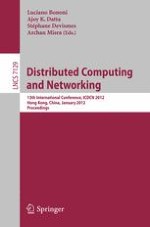This book constitutes the refereed proceedings of the 13th International Conference on Distributed Computing and Networking, ICDCN 2012, held in Hong Kong, China, during January 3-6, 2012.
The 36 revised full papers and 1 short paper presented together with 4 poster papers were carefully reviewed and selected from 100 submissions. The papers address all current issues in the field of distributed computing and networking. Being a leading forum for researchers and practitioners to exchange ideas and share best practices, ICDCN also hosts as a forum for PhD students to discuss their research ideas and get quality feedback from the well-renowned experts in the field of distributed computing and computer networking.
